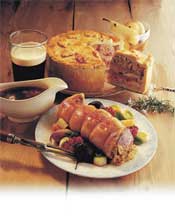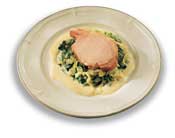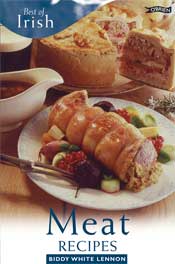Traditional Bacon with Cabbage and mustard sauce - Dry Cured Bacon
Bringing Home the Bacon

Following last week’s homage to beef and lamb in our traditional cooking, St Patrick’s weekend is a good time to remember the pig. It was probably the first domestic animal to be brought to Ireland and, although its absolute supremacy was later challenged by cattle and sheep, older readers will remember well that every country household had a pig - and its popularity has never waned until quite recently, when speciality pork butchers began to disappear.
In a price-driven market, Irish pork producers are having a tough time competing with imports – you might be surprised how many of those rashers with very Irish names come from outside the country. This is a pity, but it’s always the same when price is confused with value; it might be a different story if more producers looked at the opportunities in the niche markets that are opening up as Ireland becomes more widely recognised as ‘the food island’. There’s no reason why we couldn’t earn a world-wide reputation as specialist producers of top quality foods – GM-free, of course, and including a healthy proportion of organic production.
Meanwhile, according to Bord Bia, more Irish households are buying bacon again in retail outlets, and in larger volumes - an increase of 20% in 2005 over the previous year. (These figures were highlighted in conjunction with a Bord Bia TV advertising campaign to encourage consumers to look out for the Quality Mark when buying bacon or pork products.) To celebrate St Patrick's Weekend, Bord Bia has also produced a range of quick and easy recipe ideas for pork, bacon and other traditional Irish foods (Tel 01 668 5155 / www.bordbia.ie)
Traditional Bacon and Cabbage with Mustard Sauce
“comfort food at its best”
 Serves 6
Serves 6
1½ kg loin of Quality-Assured bacon, preferably dry-cured
1 carrot,
2 celery sticks
2 leeks
1 teasp. back peppercorns
Topping
1 tablesp. mustard (of your choice)
1 tablesp. oven-dried breadcrumbs
½ tablesp. brown sugar
Knob of butter
Mustard Sauce
50g butter
25g flour
1 tablesp. mustard
250ml mixture cooking liquid and cream
1 kg cabbage, finely sliced
To Cook
Weigh the joint then place in a saucepan with the chopped vegetables and the peppercorns, and add enough cold water to cover. Bring slowly to the boil over moderate heat, then turn down and simmer gently for approx. 20 minutes per 500g.
Preheat a fairly hot oven, Gas Mark 6, 200ºC (400ºF).
After the estimated time, remove the joint from the saucepan. Reserve the liquid; remove the rind and score the fat. Place the joint on a roasting dish; mix the mustard and bread-crumbs, sugar and a knob of butter and spread this mixture over the joint. Finish in the hot oven for 15-20 minutes.
To make the sauce
Melt the butter in a saucepan, then blend in the flour and mustard. Cook gently for a minute or two, then whisk in the reserved cooking liquid and cream. Bring to the boil, stirring. Reduce the heat and simmer gently for 3-4 minutes, stirring frequently. The sauce should have the consistency of thin cream. Taste for seasoning and keep warm while you cook the cabbage and slice the bacon joint.
To cook the cabbage
Just before serving, cook the cabbage lightly in another saucepan with some of the cooking liquid. Drain well and toss in butter. Season to taste.
To serve
Slice the bacon and serve on a bed of cabbage, with a little of the mustard sauce and, of course floury potatoes, colcannon or mash.
SHORT ITEM – Review / Best of ‘Irish Meat Recipes’ by Biddy White Lennon (O’Brien Press, paperback 96pp, EUR 7.95; no photographs).

Biddy White Lennon – a founder member and former Chairwoman of the Irish Food Writers Guild – has brought together another collection of her favourite recipes for the O’Brien Press ‘Best of Irish’ series. Once again, we have the benefit of her interest in and knowledge of social history as well as cooking, and this time she also shares her enthusiasm for Irish craft butchers.
In this book Biddy offers an eclectic range of meat, poultry and game recipes both old (Steak & Kidney Pudding, Irish Stew - no carrots! - Roast Haunch of Venison with Game Sauce & Rowan Jelly) and new (beef fillet baked in a turf crust, spiced slow-roasted belly of pork), all workable recipes, and each with introductory comments that put the dishes into context.
These are handy little books and would quickly earn a place on any kitchen bookshelf – although I can’t help feeling that the high quality of the editorial deserves to be shown off better in a more attractive format.
INGREDIENT OF THE WEEK – DRY CURED BACON
What Is It?
This is bacon which has no added water in the curing process, so it cooks without all the familiar white ‘gunk’ (which is basically water and additives water and additives) oozing out of it into the pan. A dry mixture, mainly consisting of salt, spices and flavourings, is rubbed into the raw bacon, and it is then left long enough to allow the salt to draw the natural liquids out of the meat. The curing mixture varies (closely guarded secrets, one and all) and so does the time it is left to cure.
Where Does It Come From?
It is made in Ireland by individual butchers and small producers, who tend to be very particular about the breed and lifestyle of the pigs used; also, as the popularity of dry-cured bacon grows so does the scale of production - so there are several companies now producing substantial quantities. A few examples to look out for include some from small producers like Fingal Ferguson who makes Gubbeen Smokehouse bacon (made from the family’s own pigs; Tel 028 28231, www.gubeen.com); JD Power’s bacon from the renowned butcher’s shop in Dungarvan, Co Waterford (Tel 058 42339); larger scale producers include the famous Clonakilty brand, from West Cork, Rudd’s from Co Offaly (now up and running again under new ownership) and the famous black bacon from O’Doherty’s, Enniskillen (Tel 048 6632 2152 www.blackbacon.com), which many enthusiasts would say is the best of them all, A ‘new’ arrival just starting up is ‘Prue & Simon’s’, operated by Prue Rudd (of the original Rudd’s) and her son Simon.
Where Can You Get It?
The smaller producers usually attend farmers’ markets, so your local one is a great place to look; also available from butchers (often own brand, eg J D Power’s, Clonakilty and O’Doherty’s, as above) and, increasingly, from the better supermarkets – Clonakilty and Rudd’s are now widely stocked in supermarkets. Some, eg O’Doherty’s, are available by post.
What Can You Do With It?
Dry cured bacon is a very versatile product; fried or grilled in the traditional Irish breakfast, it cooks beautifully to make the must-have crisp rasher that seemed a thing of the past until recently. It’s most often sliced and vacuum packed, but is also available in a piece to boil or bake; it’s great for warm salads, diced as a garnish, cooked in strips for pasta dishes, made into bacon rolls to accompany poultry or for nibbles with drinks – anywhere where ‘ordinary’ bacon is called for, dry cured bacon is an option worth trying. The difference can be surprising.





There are currently no comments
Leave a comment
Not a member? Register for your free membership now!
Or leave a comment by logging in with: